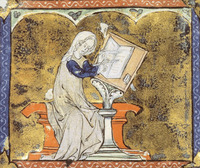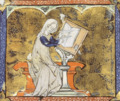Marie de France facts for kids
Quick facts for kids
Marie de France
|
|
|---|---|

Marie de France from an illuminated manuscript
|
|
| Died | England |
| Occupation | Poet |
| Period | Medieval |
| Genre | Lais, fables, saints' lives |
Marie de France was a famous poet who lived in England during the late 1100s. She was likely born in what is now France. She wrote her poems and stories for a royal court, probably for King Henry II of England. We don't know much about her life. Her name, Marie, and the idea that she was "from France" come from her own writings. She is known as the first woman to write poems in French.
Marie de France wrote in an old French language called Francien. It had some influence from Anglo-Norman, another old French dialect. She also knew Latin, Middle English, and maybe Breton. Her most famous work is The Lais of Marie de France. She also translated Aesop's Fables from Middle English into French. Another work, Espurgatoire seint Partiz, was based on a Latin text. Some people think she also wrote The Life of Saint Audrey, a story about a saint. Her Lais were very popular and helped shape the romance stories that came after them.
Contents
Who Was Marie de France?

The real name of the writer we call Marie de France is a mystery. She got this name from a line in one of her poems. It says, "Marie ai num, si sui de France," which means "My name is Marie, and I am from France."
Many people have guessed who she might have been. Some ideas include Marie, the Abbess of Shaftesbury, who was King Henry II's half-sister. Other guesses are Marie, Abbess of Reading, or Marie I of Boulogne. Based on her writings, it seems she lived most of her life in England, even though she was born in France.
Marie de France's Writings
Marie de France is known for four main works or collections of stories. Her most famous work is The Lais of Marie de France. This is a group of twelve short poems, each a few hundred lines long. She said she heard these stories from Breton minstrels, who were traveling performers. In the first lines of her poem Guigemar, she tells us her name is Marie.
She also wrote 102 fables, called Ysopet. These are short stories with a moral lesson. She retold the Legend of the Purgatory of St. Patrick. More recently, some scholars think she wrote a saint's life story called La Vie seinte Audree. This story is about Saint Audrey of Ely. However, not all experts agree on this last one.
Scholars believe Marie's works were written between about 1160 and 1215. The Lais were likely written in the late 1100s. She dedicated them to a "noble king," probably Henry II of England or his oldest son, Henry the Young King. Her Fables were dedicated to a "Count William." This might have been William of Mandeville or William Marshall. Some also suggest it could be William Longsword, who was Henry II's son. If Marie was Henry II's half-sister, dedicating a book to his son would make sense.
It is very likely that Marie de France was known at the court of King Henry II and his wife, Eleanor of Aquitaine. Another poet from her time, Denis Pyramus, wrote about Marie's lais around 1180. He said they were very popular among the rich and powerful.
Marie de France was very well-educated and knew many languages. This kind of education was rare for most people back then. This suggests she came from a noble family. Many noble women and religious women of that time were also educated and became writers.
The name "Marie de France" was first used by a French scholar named Claude Fauchet in 1581. She wrote in a French dialect from Paris, but her writings also show Anglo-Norman influences. This makes scholars think she might have lived near Normandy or in England. Many of her texts were found in England, which supports the idea that she lived there as an adult.
The Breton Lais
The Breton lais were stories told by Breton minstrels. Marie de France took these oral stories and turned them into beautiful poems. She might have been the first to create this new type of narrative poem. Her lais are a collection of 12 short poems. They are written in eight-syllable lines and are based on old Celtic legends.
Marie's lais had a big impact on literature. They were seen as a new way of writing, full of rich details. Marie may have used vivid images in her poems to help her audience remember them easily. Her lais vary in length, from 118 lines (Chevrefoil) to 1,184 lines (Eliduc). They often describe courtly love stories, sometimes with love triangles, loss, and adventure. They also often include magical or fairy tale elements.
In the Prologue to her lais, Marie de France explains her purpose. She writes that anyone who has knowledge and skill from God should share it. She believes her writing skills come from God. This allowed her to write the lais without needing her patron's full permission. She wanted people to read her work and understand her ideas. She encouraged readers to look deeper into her subtle writing. Marie de France was different from other poets of her time. She added delicate and meaningful writing to her style. She took the chance to make her voice heard. This was at a time when making books was very difficult and expensive.
The characters in Marie's stories don't usually go looking for adventure. Instead, adventures happen to them. While the settings are realistic, the lais often include magic or supernatural elements. For example, Bisclavret tells the story of a werewolf. He is shown in a kind way. Marie moves smoothly between the real world and the magical world. She also shows emotions in a very delicate way. In Lanval, a fairy woman falls in love with the main character. She eventually takes him to Avalon, a magical island. Marie's lais are set in the Celtic world, including England, Wales, Ireland, Brittany, and Normandy.
Only five copies of Marie's lais exist today. Only one of them, British Library MS Harley 978, has all twelve lais and the general prologue. This is fewer copies than her Fables, which have 25 manuscripts. This might show which was more popular long ago. However, Marie's lais have received much more attention from scholars recently.
Marie's Fables
Besides her lais, Marie de France also published a large collection of fables. Many of these fables were her translations of Aesop's Fables into English. Others came from local stories she might have heard as a child. Her collection has 102 fables. They don't always have clear rules for right and wrong. Men, women, and animals are treated differently and receive different punishments.
Marie de France introduces her fables with a prologue. In it, she explains why moral lessons are important for society. She talks about "clergie," a medieval idea. It means people have a duty to understand, learn, and save old works for future generations. She says scholars should preserve moral ideas and proverbs. Marie's prologue explains how Aesop did this for his time. Now, she must do the same for her own culture.
Each fable starts with a story. At the end, Marie de France adds a short moral lesson. Some of these morals, like those from Aesop's fables, are what you would expect. For example, The Wolf and the Lamb (Fable 2) follows a well-known story. A lamb and a wolf drink from the same stream. The wolf unfairly blames the lamb and kills him. Marie de France repeats the usual moral: "But these are things rich nobles do…destroy folk with false evidence."
In some of her new fables, Marie de France shows women as clever and powerful. She sometimes makes fun of men who are foolish. One peasant woman appears in several fables. She is praised for being smart and tricky. Fables 44, The Woman Who Tricked Her Husband, and 45, A Second Time, a Woman Tricks Her Husband, tell stories of the same peasant woman. She manages to outsmart her husband. Marie praises the woman for her cleverness and calls the husband foolish. These fables show a different kind of morality. They are part of a tradition of "wife tricking her husband" stories.
Love in Marie's Stories
In most of Marie de France’s Lais, love often brings sadness and ends in sorrow. This happens even when the love itself is good.
Marie's lovers are often alone. They care mostly about their own problems, like a jealous husband or an unkind society. However, Marie shows how they overcome this sadness in a beautiful way. She focuses on her characters as individuals. She is less concerned about how they fit into society. If society does not accept the lovers, they might die or leave society. And society becomes poorer because of it.
Challenging Old Ideas About Love
Marie de France’s lais not only show a sad side of love. They also challenged the Church's ideas about love at that time. She wrote about women who wanted to escape unhappy marriages, often to older men. Many of her lais seemed to support ideas that went against Church traditions. This was especially true for ideas about pure love and marriage.
Her lais also show women having stronger roles and more power. She might have gotten these ideas from the love songs of the time. These songs were popular in the courts of England and France. In these songs, the heroine is a mix of powerful and helpless. Marie's heroines often start the events in the stories. But these events often lead to suffering.
The heroines in Marie's Lais are often trapped. This can mean being actually locked up by old husbands, as in Yonec. In Guigemar, the lady is kept behind castle walls by the sea. Or it can mean being watched very closely, as in Laustic. Here, the husband watches his wife closely when he is home and has her watched when he is away. Perhaps these stories reflect some experiences in Marie's own life.
Marie not only challenged old ideas about love. She also influenced a type of story that stayed popular for 300 years: the medieval romance. By the time Marie was writing, France already had a strong tradition of love songs. Marie's Lais are a bridge between these older love songs and the romance stories that came later.
Marie's Impact on Literature
Marie de France's stories showed a new way of writing poetry. This influenced how narrative poems were written after her. She added new parts to her stories, like prologues and epilogues. She also created three main parts for a narrative lai:
- Aventure: The old Breton story or deed.
- Lai: The Breton melodies.
- Conte: The retelling of the story from the lai.
Marie de France also helped start a new type of literature called chivalric literature. This kind of writing is about knights, honor, and adventure.
In the late 1300s, around the same time Geoffrey Chaucer wrote The Franklin's Tale (which was a Breton lai) in his Canterbury Tales, another poet named Thomas Chestre wrote a Middle English romance. This story, Sir Launfal, was based directly on Marie de France's Lanval. It was much longer and covered more of the hero's life. In 1816, the English poet Matilda Betham wrote a long poem about Marie de France called The Lay of Marie.
More recently, Lauren Groff's 2021 novel, Matrix, is about Marie de France. It imagines her as a seventeen-year-old sent to England to lead a poor abbey.
Images for kids
See also
 In Spanish: María de Francia (poetisa) para niños
In Spanish: María de Francia (poetisa) para niños



